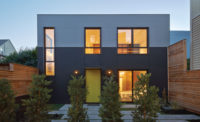Venice, California
Steffen Leisner, Ali Jeevanjee, Phillip Trigas
How do you triple the size of a house when it sits on a small lot in Venice, California? Young Los Angeles architects Steffen Leisner, Ali Jeevanjee, and Phillip Trigas faced this challenge when they collaborated on expanding a house for a couple living in a 970-square-foot, avocado-colored Venice bungalow with shingled siding and a gabled roof near Abbot Kinney Boulevard, the town’s vibrant central drag.
The owners—a filmmaker and a multimedia artist—asked the architects to provide them with 2,500 square feet of new space on the bungalow’s long, narrow lot, including living and office areas as well as an art studio and rental unit. Since the bungalow, which contains a kitchen and an entertainment area, had been renovated only five years before, there was no point in knocking it down and starting from scratch. Knowing that a large addition would dwarf the existing home, the architects added three multistory structures that distribute the new program around the site, making the existing bungalow a vital part of a new complex.
In front of the bungalow, which sits sideways on its thin site, the architects built a 7.5-foot-wide, 26-foot-long, dark concrete pool, and added a 450-square-foot, two-story structure that includes a small, carved-out front porch, a work space, and a top-floor meditation studio. Behind the bungalow, the architects added a 1,000-square-foot structure that accommodates a sunken, 12-foot-tall living room, attached via an archway where they tore down the bungalow’s east wall and a 160-square-foot second-floor bedroom. In the backyard, separated from the other two structures by a small, paved courtyard, they built a 1,065-square-foot building that contains a small, first-floor studio for renters, and a tall, second-floor artist’s loft. Above this, the architects provided the basic infrastructure for a rooftop lounge.
Spaces flow smoothly into one another: For example, the entrance hall and newly renovated kitchen in the existing bungalow opens onto the new living room. A full-height window in the living room connects the space visually to the courtyard, while an open, wall-size window in the artist’s loft offers views of the neighborhood.
By clearly differentiating the new structures, the architects complemented the bungalow rather than imitating it. In the process, they used a sophisticated modern palette of construction materials, specifying modestly priced items such as polished concrete floors, exposed plywood ceilings and doors, and greenish-blue windows with aluminum frames that kept the cost down to $700,000. The structures too are inexpensive: simple wood-frame construction with gray hard-trowel stucco walls.



